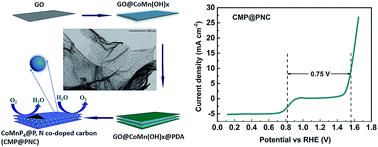Confined bimetallic phosphide within P, N co-doped carbon layers towards boosted bifunctional oxygen catalysis†
Abstract
Rational design of bifunctional oxygen electrocatalysts with high activity and low cost is crucial but still challenging for the development of rechargeable energy storage devices. In this work, a novel bimetallic phosphide confined within P, N co-doped carbon layers is achieved through a space-confinement phosphorization strategy. Electrochemical measurements demonstrate that the obtained bimetallic phosphide nanoparticle-containing hybrid can serve as a highly efficient bifunctional oxygen reduction and evolution reaction (ORR/OER) catalyst. It delivers a small potential difference of 0.75 V in 0.1 M KOH solution along with long-term catalytic durability, superior to most of the non-precious metal catalysts reported to date. The detailed synchrotron-based spectra results combined with structural characterizations reveal that the constructed hierarchical structure endows the confined bimetallic phosphide catalyst with abundant catalytic sites and stable spatial structure, thereby achieving remarkable electrocatalytic performance. This work opens up a facile way to design effective and durable bifunctional oxygen electrocatalysts for practical applications in renewable energy production, especially in rechargeable metal–air batteries and regenerative fuel cells.



 Please wait while we load your content...
Please wait while we load your content...